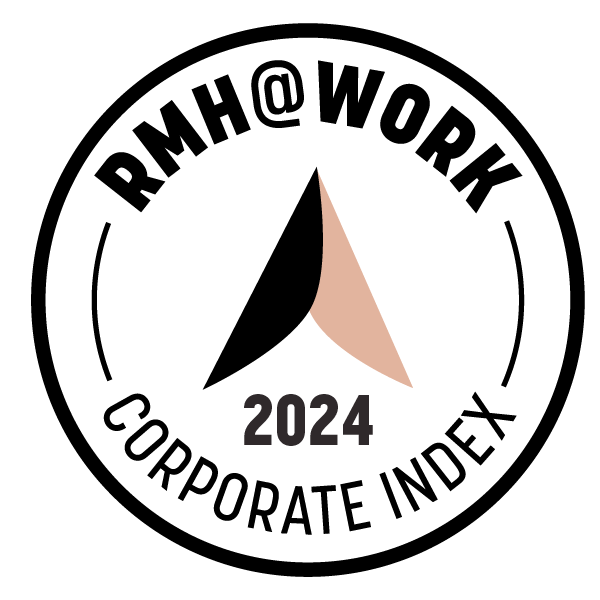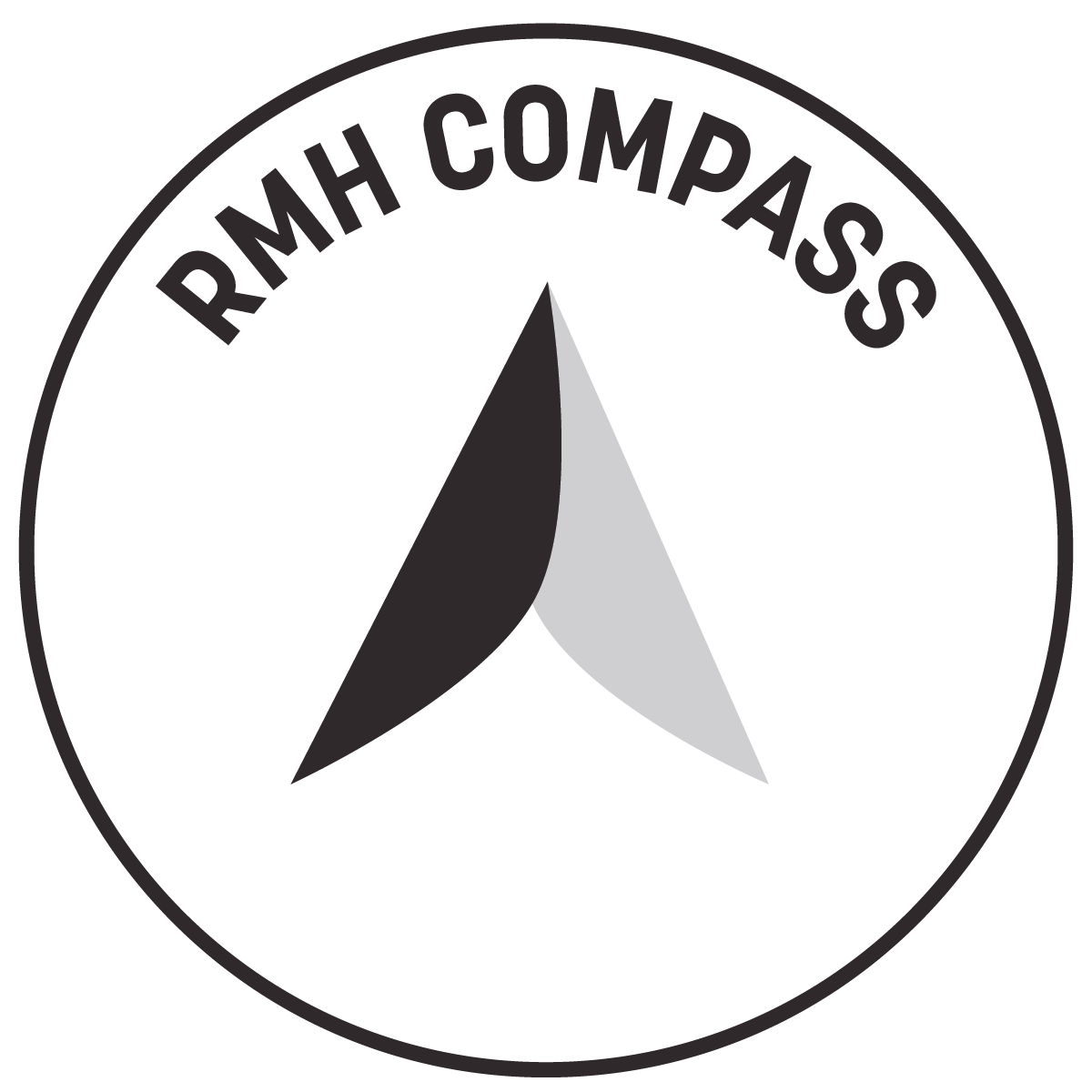
The 2024 RMH@Work
Corporate Trends Report
Benchmarking the Reproductive and Maternal Health Benefits of America’s Top Employers
Uncovering the progress, pitfalls and potential of RMH
benefits offered by leading companies in the United States

Introduction
At Reproductive & Maternal Health Compass (RMH Compass), we believe that reproductive and maternal healthcare is a basic human right. All workers, regardless of their income level, job status, geography, or identity, deserve access to comprehensive reproductive and maternal health (RMH) benefits. To fulfill our vision, we equip employers with the tools and performance insights they need to provide best-in-class reproductive and maternal health benefits for their workforce. Our independent research, rigorous methodology, and non-profit status ensure our resources are unbiased, transparent, and credible.
The RMH@Work Corporate Trends Report is the first-of-its-kind evaluation of RMH benefits provided by the largest 100 employers in the United States. The report is being launched at a watershed moment as events over the last five years have highlighted how essential these benefits are for the average American. From the caregiver crisis highlighted by the COVID-19 pandemic, the overturning of Roe v. Wade limiting reproductive health care access, to novel legal attempts limiting fertility and contraceptive care around the country, the result has been confusion and fear for American workers.
This moment presents an opportunity for employers. The United States is the only industrialized nation without universal health care, which means companies operating here are uniquely responsible for providing healthcare to their employees and families. More than half of all Americans obtain health care through employer-sponsored health plans (ESHPs). The U.S. is also the only industrialized nation without a comprehensive paid maternity or sick leave benefit.
Knowing that the responsibility of providing RMH benefits falls almost exclusively on employers, we’re committed to recognizing those companies that meet a high standard. These are employers who recognize how essential RMH benefits are for their workforce, a critical driver of their overall business health and success. Data show that productivity and loyalty improve, staff turnover declines, and top talent is more likely to accept an offer from organizations with strong RMH benefits.
We know that shifting business norms takes time. In future years, we expect to have more participation, a growing data set, and granular benchmarks for in-depth comparison. For now, encourage all employers to leverage the findings in this report to benchmark their own performance and to recognize their own progress, pitfalls, and potential. We stand ready to support all companies seeking to expand their RMH benefits coverage for their workforce.
Founder & CEO

Executive Summary
Our results show that, despite growing demand for and the popularity of comprehensive reproductive and maternal health care, the benefits offered by the 100 top U.S. employers are highly variable. Results are organized across three categories: Progress, Pitfalls and Potential.
Celebrating Progress: A majority of employers provide family formation benefits and paid parental leave, and many are using innovative approaches to ensure health coverage is accessible and affordable.
Family formation benefits are both sought after by American workers and increasingly offered by the largest U.S. employers. Our findings support the reality that providing comprehensive family formation benefits to all employees is an achievable goal.
Paid parental leave benefits are popular with employees, especially Gen Z and Millennials. Companies are increasingly offering this benefit and the average amount of paid time off is trending upward. A majority of employers offer at least six weeks of paid leave for all new parents and caregivers or eight weeks paid leave to birthing parents. Companies not meeting this standard are now in the minority.
Providing affordable and accessible health coverage is an achievable goal.
All companies offer ESHP coverage to employees who work 30+ hours a week and one-in-five companies extend benefits to part-time employees.
Employers are leveraging innovative approaches to affordability such as income-banded premiums and funded HSAs to ensure workers across a range of salaries can afford health care for themselves and their families.
Avoidable Pitfalls: Results show huge variability in benefits transparency, with companies picking-and-choosing what information they share. Lack of transparency creates a business risk.
Benefits packages represent a significant financial expenditure for companies. Failing to comprehensively disclose benefits results in lower awareness and utilization of benefits which can negatively impact workers’ health and job satisfaction and dissuade prospective employees from applying or accepting a job.
Medically-necessary abortion and medicated abortion are covered by the majority of ESHPs surveyed, but given the general lack of transparency, workers may not realize that abortion is covered by their health plan.
With the prevalence of statewide reproductive health bans, transparency around medical travel reimbursement for RMH care is critical for large companies who have employees in impacted states. Thoughtfully developing a travel reimbursement benefit and clearly communicating it to workers ensures the health and well-being of workers is clearly addressed.
The need for transparency of shift work scheduling policies is an easily-solvable pitfall – it eliminates confusion around shift work norms and ensures alignment across people managers and workers.
Potential: Our research reveals several opportunities that present “easy wins” for the largest U.S. companies to strengthen their reproductive and maternal health offerings.
Add pre- and post-natal health services such as doula and midwifery care to support pregnant workers’ overall health, thus improving outcomes and lowering medical costs.
Establish inclusive eligibility criteria for family formation benefits to eliminate barriers to obtaining care.
Provide paid bereavement leave for miscarriage, stillbirth, and fetal loss.

Today’s Benefits Landscape
Most Americans get their health benefits through their jobs, yet the majority of U.S. corporations have been slow to recognize a critical workplace issue: employees need and want supportive reproductive and maternal health benefits.
According to Mercer’s 2024 Global Talent Trends Report, employees rank working for a values-aligned company as the most important factor for thriving at work.
72 percent of U.S. workers cite women’s¹ reproductive health as the most pressing social issue.
One-third of workers say they would forgo a pay raise for a stronger benefits package.
73 percent of workers would be motivated to stay at their company if it offered better healthcare benefits.
Reproductive Health Benefits
A 2023 survey from consulting firm Mercer found the number of workers who want access to fertility support, lactation support, postpartum care, contraceptive coverage, and abortion care significantly outnumber employers who provide these benefits. Moreover, men and women prioritize the importance of these benefits at equal rates, indicating this is a priority for all workers.
Numerous studies have found that companies offering RMH benefits experience improved productivity and loyalty, lower staff turnover, and are better able to attract top talent.
DID YOU KNOW?
Family formation benefits result in an estimated return-on-investment of 4:1 ($4 of value in the form of loyalty and retention for every $1 spent). The turnover rate for postpartum workers drops from 33-43% to 10-13% when employers provide 12 weeks of paid parental leave. While the cost of leave is 25% of an employee’s annual salary, the savings in avoided replacement expenses of 33% of an employee’s annual salary is a net positive for employers.
While the range of benefits offered depends on the employer, there is a persistent lack of clarity around benefits available to workers. This opacity impedes workers’ ability to utilize the benefits available to them and impairs the ability of job-seekers to make fully-informed decisions.
RMH Compass set out to solve these challenges by encouraging transparency and driving deeper awareness of the full range of reproductive and maternal health benefits that should be broadly available.
¹ We use the word “women” expansively to be inclusive of transgender and gender nonconforming people, intersex people, as well as other gender identities who share reproductive experiences such as menstruation and menopause.

Data & Methodology

The RMH@Work Corporate Trends Report includes the 100 largest U.S. employers – ranked by headcount – that collectively employ over 21 million workers. Roughly 15 percent of American workers are employed by these companies, and their jobs are diverse, from full-time salaried to part-time, hourly, and unionized labor. What they have in common is that their employers are able to define their health plan benefits.
DID YOU KNOW?
Larger employers – generally those with 300+ workers – opt for self-insured health plans where the employer, rather than an insurance company, is responsible for paying employees' medical bills. Self-insured plans are subject to federal ERISA guidance, giving them the flexibility to define what medical procedures are (and are not) covered by their health plans.
In addition to having the flexibility to define their employer-sponsored health plans (ESHPs), these companies are most likely to have clearly-defined workplace policies, given the size of their workforce and organizational scope.
In April 2024, we invited these 100 companies to share information about their reproductive and maternal health benefits through the RMH Compass Survey.
The RMH Compass Survey is organized around four core principles that cover 16 reproductive and maternal health benefits and policies:
To learn more about the development and methodology of the RMH Compass Survey, visit the Appendix.
In addition to data provided by companies directly, we used publicly-available data and detailed health plan data included in Transparency in Coverage (TiC) machine-readable files for In-Network Negotiated Rates.². TiC machine-readable files are legally required to be made publicly available for all health plans, including ESHPs. While available to the public, these files tend to require expertise in data processing and are not designed for everyday consumers.
Five companies completed the RMH Compass Survey and provided documents to validate their data. With the addition of publicly available data, on average we were able to populate 35 percent of the RMH Compass Survey. The information provided below reflects the most accurate and complete data made available by these employers and is the most comprehensive analysis of benefits offered by this cohort of companies to date.
Given the sources of data, there are a few caveats to the insights below. While ensuring that benefits are available to the whole workforce is a priority in our approach, this report includes instances where benefits extend only to full-time and regular part-time (i.e., 20 hours/week) employees.
In addition, unionized workers often have access to different benefits depending on their negotiated union contracts, such as receiving health insurance through union-managed health plans. As a result, while we endeavor to reflect benefits available to the whole workforce, some data included below may reflect a partial workforce. Lastly, since public data relies on company transparency, more companies may be offering the benefits covered below than what is reflected in this report.
² 64 companies whose data was extracted through TiC machine-readable files for at least one employer offered health plan are included in the TiC sample set.

Insights
Celebrating Progress
A majority of the largest employers provide family formation benefits and paid parental leave, and many are using innovative approaches to ensure health coverage is accessible and affordable.
Family Formation Benefits
Family formation benefits include infertility treatments such as diagnostics, intrauterine insemination (IUI), in vitro fertilization (IVF), as well as surrogacy and adoption support.
DID YOU KNOW?
In the U.S., one in 42 babies is born as a result of IVF or other fertility interventions.
Key Takeaways
If and when they are needed, family formation benefits are popular and commonly used by American workers. They are also increasingly offered by the largest 100 U.S. employers. Our findings support the reality that providing comprehensive family formation benefits to all employees is an achievable goal.
Paid Parental Leave
Without federal policies mandating paid parental leave for the birth of a child, adoption, or surrogacy, the U.S. is an outlier amongst industrialized nations. Unsurprisingly, access to paid parental leave is a high-priority benefit for all workers, particularly Gen Z and Millennials.
Paid parental leave typically has two dimensions: parental bonding leave, to care for a new family member, and leave for the birthing person’s recovery. Over the past decade paid parental leave has become a more common benefit, though there is significant variation in how generous these leave plans are.
BEST PRACTICES IN ACTION
This year, a large financial-services firm enhanced its paid parental leave benefit for its U.S. workers. Called “Paid parental bonding leave”, this benefit is available to all employees who regularly work 20+ hours per week and offers 16 weeks of job-protected leave at 100% base pay. The benefit extends to all new parents to “care for and bond with a new child, whether through birth or adoption.”
Key Takeaways
Paid parental leave benefits are popular with employees. Companies are increasingly offering this benefit and the average amount of paid time off is trending upward. A majority of employers offer at least six weeks of paid leave for all new parents and caregivers or eight weeks paid leave to birthing parents. Large companies not meeting this standard are now in the minority.
Accessible and Affordable Employer-Sponsored Health Coverage
Whether workers have access to comprehensive reproductive and maternal health care depends on how employers structure the eligibility and affordability of their health plans.
Eligibility
Our research finds that:
34 companies extend ESHP eligibility to full-time workers only (under ACA requirements, this includes workers who regularly work 30+ hours per week).
22 companies included in the survey extend ESHP eligibility to workers who regularly work 20+ hours.
Affordability
Affordability of ESHPs is dependent on how committed and able an employer is to making healthcare reasonably priced. Our standard considers two strategies for ensuring affordability: the first is to pair a high-deductible health plan (HDHP) – a low-cost plan with a high-deductible – with a health savings account (HSA), which enables pre-tax savings for health-related expenses. The second strategy is to offer a plan where premiums are set by income bands.
46 companies offer a HDHP with an unfunded HSA
27 companies offer a HDHP with a HSA funded to $500 (individual) and $1000 (family)
2 companies offer a HDHP with a HSA funded to $1000 (individual) and $2000 (family)
9 companies offer an income-banded premium structured health plan
Income-banded premium pricing is a great way to make health plans affordable, though administering the income bands can be complicated⁴. Workers with a lower base compensation pay a lower monthly premium, while high-income earners pay a higher monthly premium. This approach ensures that workers are better able to choose the best health plan offering for themselves and their families given their health needs.
Key Takeaways
Providing affordable and accessible health coverage is an achievable goal.
All companies offer ESHP coverage to employees who work 30+ hours a week and one-in-five companies extend benefits to part-time employees.
Employers are leveraging innovative approaches to affordability such as income-banded premiums and funded HSAs to ensure workers across a range of salaries can afford health care for themselves and their families.
³ These plans typically affirm Family and Medical Leave Act (FMLA) access, which is unpaid leave, or cover 2-4 weeks of paid leave
⁴ With income-banded premiums, it is possible for an employee to receive a salary raise and corresponding premium increase that could result in a net negative on net compensation. To avoid this perverse scenario, employers must consider their overall compensation approach when setting income bands.

Avoidable Pitfalls
Results show huge variability in benefits transparency, with companies picking-and-choosing what to share. While abortion is covered, there are access and disclosure challenges.
Transparency
Lack of transparency is a pitfall: employees don’t have information about their benefits, job-seekers are forced to make employment decisions based on partial information and companies don’t know if their benefits packages are competitive.
DID YOU KNOW?
50 percent of employees believe having a better understanding of their benefits would make them more loyal to their employer. 47 percent of employees say they don't understand their total health care costs.
Thirty percent of total compensation is allocated to employee benefits. Though all companies make a significant financial investment in these offerings, some disclose very little or no information about their benefits, others opt to share some information, while a smaller population releases comprehensive information about their benefits publicly.
Out of 100 companies…
DID YOU KNOW?
27 percent of women report delaying preventive health care in reaction to political attacks on reproductive health since 2022. Delaying care can negatively impact overall health and wellbeing. Ensuring workers have complete, accurate information about their health plan coverage promotes a healthy workforce.
Disclosure is spotty within and across industries. Though we expected companies that primarily employ full-time, salaried, more educated workers to offer stronger overall benefits packages and thus be more transparent, some disclose no information publicly. While they may offer excellent benefits packages, there is no way to independently verify this. Other companies that use significant hourly and/or part-time workers – such as retailers – are transparent about a range of their RMH benefits and demonstrate a more comprehensive set of benefits than might be expected.
Key Takeaways
Benefits packages represent a significant financial expenditure for companies. Lack of transparency results in lower awareness of benefits, which can negatively impact workers’ health, job satisfaction and dissuade prospective employees from applying to or accepting a job. When more companies are transparent, insights on competitors’ benefit offerings will help employers determine how they measure up and where they need to improve their benefits structure to stay competitive.
Abortion Access and Travel Reimbursement
One in four women between the ages of 18 and 45 has had an abortion during her reproductive lifetime.
DID YOU KNOW?
According to a Gallup Poll from May 2024, 85 percent of Americans believe abortion should be available in some or all instances.
Our assessment of abortion care considers two dimensions: what is covered by health plans and what information is publicly shared. Regarding coverage, data from TiC machine-readable files for ESHPs show that all companies whose data was reviewed cover both medically-necessary abortion and medicated abortion (coverage of mifepristone and misoprostol). This suggests that all or nearly all companies do cover abortion through employer-sponsored health plans.
DID YOU KNOW?
A 2023 Kaiser Family Foundation survey found that 40 percent of benefits administrators at large companies did not know whether their health plans covered abortion. This lack of knowledge by HR leadership suggests that an average employee would also lack the information.
However, fewer companies disclose this data:
Fewer than half of companies have made this information transparent. Given that abortion access is banned in 14 states and has restrictions in 27 others, information on how to access this health benefit if needed is critically important for workers. It also underscores the importance of travel reimbursement and sharing coverage information.
There are several ways to offer travel reimbursement to workers. Employers can opt to include travel reimbursement in an ESHP, though it is critical to ensure that those reimbursement plans include travel for reproductive care. We found some ESHPs cover travel costs for a narrow set of medical needs such as organ transplant and joint replacement, but not reproductive health.
Another limitation of reimbursement through an ESHP is that rates are set by the IRS and may not cover the full cost of travel. For example, lodging is capped at $50/night ($100 if traveling with a companion) and mileage reimbursement is often lower than the cost of gas. With these limitations in mind, some companies have implemented travel reimbursement that is administered through corporate travel programs or other mechanisms. The downside to this approach is that data may not be confidential and could be compromised. Unlike ESHPs, these mechanisms are not subject to HIPAA data privacy. This reimbursement could also be classified as taxable income.
Our research found that 33 companies have public information about their travel reimbursement policy⁵. Employers should be transparent about medical travel reimbursement for workers, especially since all 100 companies surveyed operate in states with reproductive health bans in place. It is critical that these policies articulate how data will be kept private and confidential to ensure employee safety.
Key Takeaways
Medically-necessary abortion and medicated abortion are covered by the majority of ESHPs surveyed, but availability of these services depends on the state. Given the lack of transparency about this benefit, most workers may not realize that abortion is covered by their health plan.
With the prevalence of statewide reproductive health bans, transparency around medical travel reimbursement for RMH care is critical for large companies with employees in impacted states. Thoughtfully developing and communicating a travel reimbursement benefit should be a priority for all employers to ensure the health and well-being of workers.
Shift Work Scheduling Policies
According to the Bureau of Labor Statistics, one in five workers have “shift jobs,” where working hours are typically scheduled in 8-hour shift segments that provide necessary operational coverage for the employer. For shift workers, having transparency into shift-scheduling policies and advance notice of work schedules are important for balancing work-life responsibilities, especially during the 12-month postpartum period when childcare needs are especially intense.
While most companies included in our survey leverage shift-scheduling software, none of them are transparent about what their shift-scheduling policies are. Some shift work best practices include: setting schedules two weeks in advance, allowing workers to swap schedules, guaranteed show-up pay (even if a shift is shortened or canceled), and prohibiting “on call” scheduling (where workers are on stand-by, and must be available to work if needed). Workers are better able to thrive when these norms are adhered to.
Key Takeaways
The need for transparency of shift work scheduling policies is an easily solvable pitfall – it eliminates confusion around shift work norms and ensures alignment across people managers and workers. This matters to all workers and especially benefits working parents.
⁵ Several of those policies do not explicitly reference abortion care but do underscore that reimbursement is for “any medically-necessary travel.”
Plenty of Potential
Our research reveals several opportunities that present “easy wins” for the largest U.S. companies to strengthen their reproductive and maternal health offerings.
Pre- and Post-Natal Services
Data show that workers want access to pre- and post-natal support outside of their regular prenatal medical care. Companies should be eager to offer these benefits as they improve health outcomes and equip workers emotionally and physically to return to work.
DID YOU KNOW?
Data show that health outcomes are improved dramatically by access to pre- and post-natal doula services, particularly for Black women. The impact of doula care includes lower cesarean births, fewer preterm births, a reduction in post-birth complications, and higher breastfeeding rates. The benefit pays dividends; providing prenatal doula benefits to pregnant employees saves employers $1,193.94 per employee in averted c-sections alone.
Doulas are trained support professionals who provide care to pregnant and postpartum birthing persons outside of their regular prenatal medical care. When the cost of a doula benefit is compared to the savings from avoiding serious health complications, the net economic impact is positive, and the impact on the individual birthing person can be life saving.
While 21 state Medicaid programs cover doula services, doula benefits are relatively rare among self-insured employer health plans⁶.
Of the 100 companies surveyed, 70 companies do not have any public-facing data regarding midwifery, doula, or lactation support benefits.
Only 12 companies explicitly reference doula services, with only four covering $1500+ in doula care.
Maven, Progyny, and Carrot offer optional doula benefits via their platforms (though companies must opt into this benefit).
BEST PRACTICES IN ACTION
One participating company’s Employee Handbook states: “Coverage for fertility treatment is available to all employees and eligible dependents enrolled in [our] medical plans, regardless of sexual orientation, gender, gender identity or expression. An infertility diagnosis is not required.” This language meets the ASRM standard.
Paid Bereavement Leave
It’s estimated that approximately 15 -25 percent of all pregnancies result in pregnancy loss through miscarriage and/or abortion. Given there are roughly 5 million pregnancies each year in the U.S., this means more than a million pregnancies are lost each year. Pregnancy loss can cause significant physical and emotional complications for pregnant people and their partners.
Bereavement leave is generally defined as leave to support workers who have experienced the death of an immediate family member.
Having access to paid bereavement leave that includes stillbirth and miscarriage can provide necessary time away from work for employees. Knowing this time away is paid fosters a sense of worker gratitude and loyalty.
Inclusive Access to Family Formation Benefits
While coverage of family formation benefits is a bright spot, companies can strengthen access by ensuring that benefit eligibility meets the American Society for Reproductive Medicine (ASRM) standard.
In late 2023, ASRM released updated language that defines infertility as “the failure to achieve a successful pregnancy based on a patient's medical, sexual, and reproductive history, age, physical findings, diagnostic testing, or any combination of those factors.” Some companies still require a medical diagnosis of infertility and only three companies surveyed meet ASRM standards of inclusion. Removing diagnostic requirements, which create an unnecessary burden for same-sex couples, ensures more equitable access.
BEST PRACTICES IN ACTION
One large healthcare provider offers paid bereavement leave for the loss of immediate family members. The bereavement leave policy includes detailed definitions of immediate family members, including loss of family members of domestic partners, “including stillborns and those dying in utero, including miscarriage.” The benefit is available upon hiring and extends to full-time and regular part-time employees.
Key Takeaways
There is plenty of potential for strengthening RMH benefits with low-cost policy improvements and benefits.
Add pre- and post-natal health services such as doula and midwifery care to support pregnant workers’ overall health, thus improving outcomes and lowering medical costs.
Establish inclusive eligibility criteria for family formation benefits to eliminate barriers to obtaining care.
Provide paid bereavement leave for miscarriage, stillbirth, and fetal loss.
⁶ Fully-insured ESHPs used by small and medium-sized companies must cover doula care in states where it is mandated.

Our Vision for the Future

The 2024 RMH@Work Corporate Trends Report highlights novel insights in the reproductive and maternal health benefits landscape. Progress has been made with the increasing availability of family formation benefits and paid parental leave. For large companies not yet offering these benefits, now is the time to add them.
Pitfalls include an overall lack of or inconsistent transparency of benefits, especially regarding abortion care, medical travel reimbursement and what’s available to shift workers. Ensuring that transparent and comprehensive benefits information is available to current and prospective employees is an administrative task; companies can and should solve this issue.
There is potential for strengthened RMH benefits across the board, with the addition of doula care, more inclusive family formation, and bereavement leave policies as low-cost investments to focus on first.
The RMH@Work Corporate Trends Report is designed to motivate employers to take action to provide best-in-class benefits. If your company does not offer these benefits, consider this report your call-to-action. If you offer these benefits, ensure the information is publicly available. Our website, rmhcompass.org, has resources to help you get started.
While we are heartened to have found public data for many of the largest public companies, our goal is to expand participation and improve the transparency of workplace benefits over time. Going forward, this report will provide industry benchmarks and more targeted performance insights. We will celebrate employers that meet a high standard of RMH benefits provisions, so that those leaders can be recognized by current and future employees.
The business case is clear: providing comprehensive reproductive and maternal health benefits gives employers a competitive edge for recruiting and retaining top talent. A happier, healthier workforce is a more productive, committed workforce. That’s good news for employers and their workers.
Acknowledgments
The release of the inaugural RMH@Work Corporate Trends Report is the culmination of a two year effort that would not have been possible without the hard work, resourcefulness, and expertise of Emma Russon, Head of Data and Technology and our 2024 Research Fellows, including Maya Schoucair, Anna DeBettencourt, and Usama Faheem. We’re grateful for their tenacity and attention to detail while assembling the report. In addition, board members Maddie Livingston, Shawnie Hawkins, Shelley Alpern and advisors Kelly Gardiner and Anthea Kelsick provided helpful feedback and guidance throughout the process. This report was made possible through the generous philanthropic support of W.K. Kellogg Foundation, Ford Foundation, The Educational Foundation of America, and others.
Appendix
As a nonprofit organization, our independent research and rigorous methodology ensure our tools and resources are unbiased, transparent, and credible. Through our work, we are building a business community that understands the value of RMH benefits and is committed to ensuring access for workers at every level.
History of the RMH Compass Standard
The development of the performance standard for RMH Compass was informed by our Founder & CEO Flory Wilson’s experience developing the B Impact Assessment and methodology at B Lab. Based on her experience developing that evaluation tool, scoring model and standards working group, Flory replicated many of the same best-in-class framework practices while developing the standard for RMH Compass.
Governance
Oversight of the RMH Compass Standard is the responsibility of RMH Compass’ Standards Advisory Working Group (SAWG), an independent committee composed of individuals with subject-matter expertise and experience in topics related to reproductive and maternal health. The SAWG has advised on the framework to set a best-practice standard for corporate benefits and policies, providing input on the range of topics (benefits and policies) included in the framework and reviewed research compiled by the RMH Compass team. Lastly, the SAWG reviewed the scoring methodology and the survey that allows companies to evaluate their performance on the RMH Compass Standard.
Standards Advisory Working Group (SAWG) Members
Working group experts and practitioners in the field of reproductive and maternal health include:
Amy Beacom, Founder and CEO, Center for Parental Leave Leadership
Jennifer Weiss-Wolf, Executive Director, Birnbaum Women’s Leadership Center @ NYU Law
Kanika Harris, Director of Maternal Health, Black Women’s Health Imperative
Mia Dell, Deputy Directory, Advocacy, AFL-CIO
Oriaku Njoku, Executive Director, National Network of Abortion Funds
Natalie Silverman, CoFounder, Fertility Matters @ Work
Shawnie Hawkins, Senior Director for the Workplace Equality Program, Human Rights Campaign
Shelley Alpern, Director of Shareholder Advocacy, RHIA Ventures
Sunita Thakkar Mahtani, Vice President, Corporate Engagement, Planned Parenthood Federation of America
RMH Compass Survey
The survey is designed to be:
Research-Based: Leveraging independent, credible research that measures the provision of different health benefits and policies from a variety of sources allows us to ensure that our standard is rooted in data.
Aspirational: Each Topic in the RMH Compass standard has three performance tiers that we think of as good, better, and best-in-class. The reality is while many companies will reach the good or better standard for some topics, few companies will reach the best-in-class standard in any area. This is intentional; we want all companies to be able to identify opportunities for improvement while celebrating their current strengths.
Informative: RMH Compass is designed to inform and support users to improve their RMH benefits performance. Our Resource Hub includes supplemental resources such as sample policies, real-world case studies, and business case data that explains how RMH benefits can create value for a company.
Confidential: All data submitted to RMH Compass by companies are strictly confidential. For benchmarking and research purposes, data is shared in aggregate (no fewer than 4 companies per data point) and anonymized. More information is available in our privacy policy.
Evolving: As norms shift over time, so too will our performance standard. The RMH Compass standard will be revised on a two-year cycle, with input provided by corporate users, subject-matter experts and our Standards Advisory Working Group.
The performance standard of the RMH Compass is guided by four principles that were developed by a group of reproductive justice and reproductive health experts. Sixteen (16) specific Topics were identified as critical to meeting the principles. These Topics cover a range of health benefits and workplace policies that support reproductive and maternal health of workers.
Three performance tiers were identified for each of the 16 Topics. Performance tiers focus not just on the provision of particular benefits, but who in the company qualifies for them. Ensuring equity in access and cost coverage or reimbursement is the focus of best-in-class performance tiers. For more details on the methodology and scoring, visit our website.



































